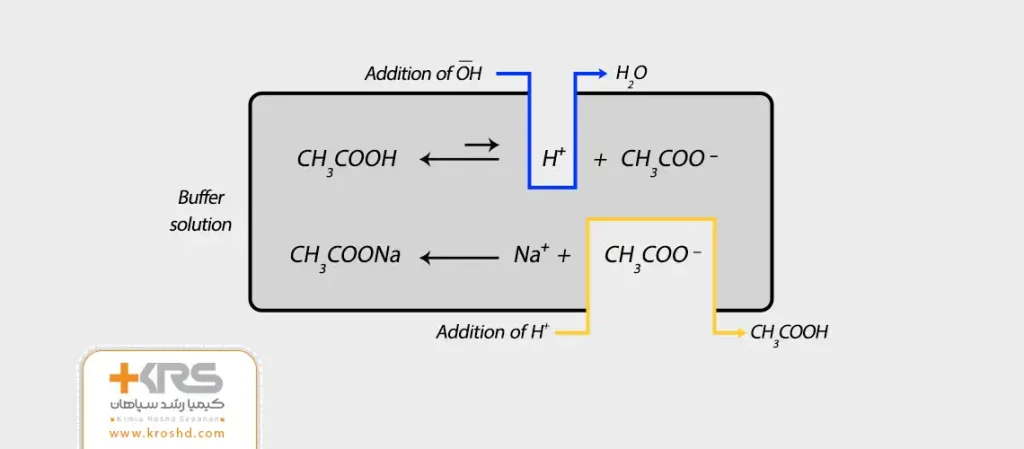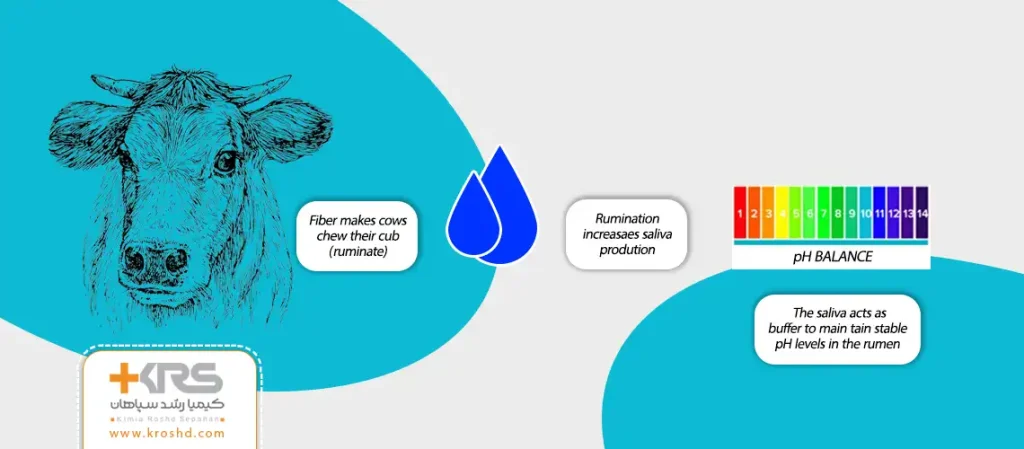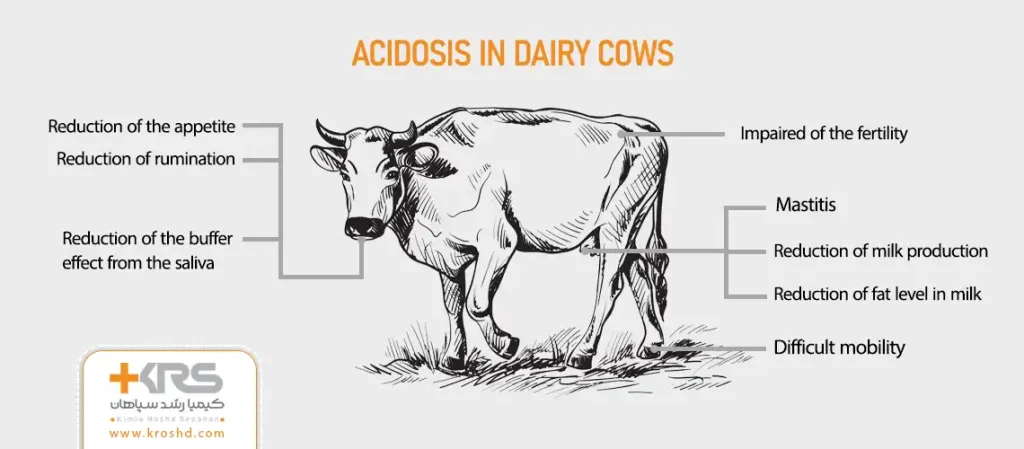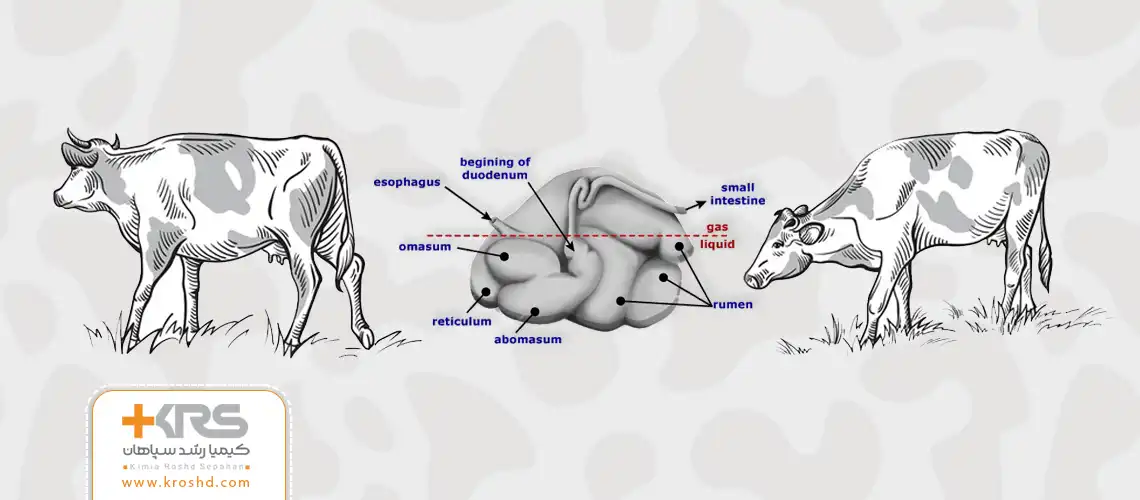Rumen buffer
Rumen buffer is a combination that fights to increase the acid concentration in ruminants’ rumen. Rumen buffer is a weak acid and its salt or a weak base and its salt. Rumen buffer helps to resist rumen at equal to change acidity when consuming high concentrate rations. Rumen Buffer increases the acetate-to-propionate ratio and thus improves fiber digestion. Rumen buffers work differently than alkalizers. Their great advantage is that maintain the rumen pH in a limited range while alkalizeres (magnesium oxide and magnesium hydroxide) change the pH according to the amount of acid or base added.

what are the natural buffering systems in the body of ruminants?
The regulation of acids and bases in the ruminant’s body is controlled by slight changes in hydrogen ion concentration, which may reduce or accelerate chemical reactions in cells. A high concentration of hydrogen ions leads to acidosis. To prevent acidosis, the body uses three natural systems:
- The acid-base buffer system of body fluids, which immediately reacts with acid or base to prevent excessive changes in hydrogen ion concentration in fluids and the occurrence of acidosis or alkalosis.
- Respiratory centers that regulate pH by removing CO2 and then H2CO3 from the extracellular fluid.
- The kidneys by excreting acidic or alkaline urine, make the hydrogen ion concentration of the extracellular fluid normal.

What are the ingredients in rumen buffer?
The most common rumen buffer is sodium bicarbonate with the generic name ” Baking soda ” and the Chemical formula NaHCO3. Bicarbonate sodium is a white, solid, and powdery salt compound. This rumen buffer is an amphoter in water and can act as an acid or base. Although it is still widely used, it has a major problem. The very high solubility of this rumen buffer although is effective in maintaining rumen pH and reducing the risk of acidosis, it has a negative effect on feed digestion. In fact, this rumen buffer by increasing the speed of passing through the rumen and reducing digestion reduces the occurrence of acidosis. Therefore, it is recommended to use a slower-release rumen buffer to neutralize rumen acid for a longer period of time.
Importance of ruminal buffers in dairy cattle nutrition?
Meeting the needs of high-yielding cows would be possible by allocating a large part of the cows’ ration to concentrate. This diet change has caused digestive disorders and many production and reproduction problems. The optimal pH for proper rumen performance is between 5.5 and 6.8. If the pH of the rumen is not within this range, will increase in feed intake will occur acidosis, will increase in milk fat and manure consistency, and as a result, the health of cows will be at risk. Research has shown that a cow that is fed a diet containing 30 % forage naturally produces about 200 grams of sodium bicarbonate less than a cow that consumes the same dry matter but with 70% forage in the diet. As well as, low-forage rations, are more acidic in nature. Adding rumen buffer to the diet of animals is one of the best nutritional strategies to adjust the pH of the rumen and its microbial activity.
When rumen buffer should be used?
The use of rumen buffer In the following cases will solve nutritional problems and the occurrence of diseases related to them:
- The forage part of the ration is low (less than 45 %) .
- Ensiled corn and other wet and fermented forages are the main sources of the forage part of the diet.
- The amount of dry matter intake at the beginning of lactation is less than the standard amount.
- Loss of appetite or lack of uniformity in food consumption is observed.
- The size of the forage pieces is small.
- There are restrictions on the consumption of hay.
- The amount of fiber of the diet is less than 19% ADF.
- Dry matter ( DM ) of diet is less than 50 % .
- Milk fat is less than standard
- There is a possibility of acidosis, lameness, soft poison, and abscess.
- Cows are under heat stress.
What is the role of rumen buffer in feeding dairy cows?
A) What is the role of rumen buffer on dry matter intake?
Since rumen buffer has the ability to stabilize the pH of the rumen, it has the ability to digest cellulose more efficiently, increase circulation, and decrease rumen filling, and as a result, increase dry matter intake as well. In one study, the weight gains of calves that were fed with rumen buffer were more. Manure of calves fed with rumen buffer had less starch and higher pH. The most significant advantage of using rumen buffer was the reduction of 44 % of the required feed per unit of weight gain in calves fed with rumen buffer.
B) What is the role of rumen buffer on rumen fermentation?
Adding rumen buffer to the cow diet can increase the rumen VFA concentration and change the molar ratio of acetate to propionate. In a study with cows that were fed a diet containing 75% concentrate and rumen buffer supplement, the ratio of acetate: to propionate increased from 1.31 to 2.0. The reasons for the change in rumen fermentation are not known. It may be related to the change in the rumen microbe population, the change in the metabolism of the rumen microbes towards the production of more acetate and less propionate. It may also be caused by the increase in the dilution rate of the rumen fluid due to the increase in the flow of water into the rumen as an attempt to regulate the osmolality of the rumen. In any case, the milk fat will increase because acetate is the main precursor of milk fat synthesis. In other cases, milk fat content does not usually correlate with higher acetate: propionate ratio and may be due to physiological and genetic factors, propionate moves to tissues instead of milk production.
c) What is the role of rumen buffer on milk yield and milk composition?
Rumen buffer increase milk production efficiency in dairy cow, by increasing dry matter intake and digestibility of nutrients. Rumen buffer maintains milk fat as well as by the mechanism mentioned above. Research has shown that cows that use rumen buffer continuously have higher milk fat, due to the increase in the ratio of acetate to propionate by almost two times. Rumen buffer by improving the activity of rumen microbes increases the amount of protein used in the diet, and by increases the percentage of milk protein by improving rumen microbial protein.
d) What is the role of rumen buffer on nitrogen efficiency?
Rumen buffer consumption leads to increase nitrogen efficiency and reduce NH3 emission. In addition, it helps the proper functioning of the rumen, the proper protein-energy balance, increase of digestible protein in the intestine. In fact, the use of rumen buffer maximized the production of microbial protein and the amount of usable protein in the small intestine.
e) What is the role of rumen buffer on rumen acidosis?
Suffering from acidosis accelerates the passage of food through the digestive tract and reduces the time of microbial digestion. In addition, in these conditions, the microbial population undergoes many changes and loses the ability of microbial digestion of feed to a large extent. Rumen buffer by preventing the excessive growth of acid-resistant bacteria (lactobacillus) and the growth of the bacterial population by maintaining the ideal pH, improves the fermentation process in the rumen, and increases digestion and feed consumption.

The negative energy balance in newborn cows leads to the breakdown of their fatty tissue in order to meet energy. This leads to an increase in the entry of free fatty acids into the liver, the production of ketone bodies, and the occurrence of ketosis. Rumen buffer by improving rumen activity, ) reduces the level of ketone bodies in the blood and the problems caused by them.
Occurrences of lameness, displaced abomasum, and metritis are related to the occurrence of ketosis, acidosis, and metabolic diseases of the transition period through the reduction of dry matter intake. In this sense, the use of a rumen buffer with suitable capacity can prevent several metabolic and non-metabolic diseases in livestock.
what is the best rumen buffer?
Ideal rumen buffer should be soluble in water and have a pKa close to the physiological pH of rumen fluid. Researchers tested the buffering capacity of 35 substances in the laboratory on the rumen fluid of cows fed diets containing only concentrate or concentrate with forage. The results indicate rumen buffers containing sodium are the best types of buffers. potassium Calcium and calcium are better than calcium and calcium is better than aluminum, magnesium, manganese, and ammonium. The best buffer anions include acetate, bicarbonate, carbonate, and diphosphates. Borate, citrate, lactate, and propionate are weak anions and microliters are moderate buffers. Bentonites are good buffers when allowed to dissolve in rumen fluid The buffering capacity of sodium sesquicarbonate is the best, followed by the combined buffer, sodium bicarbonate, and zeolite.
The effect of different rumen buffers on digestive parameters.
| Table of effect of different rumen buffers on digestive parameters. | ||||
|---|---|---|---|---|
| Parameter | Sodium Bentonite | Magnesium Oxide | Limestone | Sodium Bicarbonate |
| pH | + | + | 0 | + |
| Acetate: Propionate | + | + | 0 | + |
| Fiber digestion | + | + | 0 | + |
| Digestion of starch | + | + | 0 | 0 |
| Feces | 0 | + | + | 0 |
| Fiber digestion | 0 | + | + | 0 |
| Digestion of starch | 0 | 0 | 0 | 0 |
Points to consider in using rumen buffer?
Rumen buffers should not be routinely used to compensate for improper feed management. And nutritional management in all cases should be considered based on the needs of livestock at certain production levels. For reasons that are not fully understood, Rumen buffers often reduce the intake of whey-based diets but increase the intake of silage-based diets. The use of sodium or potassium bicarbonate (as a buffer) in combination with an ionosphere (such as monensin, lasalocid, etc.) may eliminate the effect of the ionophore on feed efficiency. If the buffers are to be supplemented in the diet, it may not be economical to use ionophore along with it.
rumen buffer price
The price of rumen buffer is mainly determined according to the volume, quality, and purity (like other additives) but the capacity and power of each gram of rumen buffer in adjustment of rumen pH, neutralization of rumen acidity, retention in the rumen are important factors in determining the price of the rumen buffer
Rumen buffer production factory
The abnormal spread of SARA disease in the dairy farms of Isfahan province (despite the continuous consumption of baking soda in the diet), prompted us to look for a rumen buffer to replace this traditional buffer. We made a slower-release buffer with 30% higher capacity than baking soda. The formula of Kimiabaf is adjusted carefully and based on the results of farm experiments and is made in the factory in compliance with all the criteria of a standard production line.
Frequently asked questions for Rumen buffer
What is rumen buffer?
Rumen buffer is a combination that fights to increase the acid concentration in ruminants’ rumen. Rumen buffer is a weak acid and its salt or a weak base and its salt. Rumen buffer helps to resist rumen at equal to change acidity when consuming high concentrate rations.
what is the best rumen buffer?
Ideal rumen buffer should be soluble in water and have a pKa close to the physiological pH of rumen fluid.
Point to consider in using rumen buffer?
Rumen buffers should not be routinely used to compensate for improper feed management. And nutritional management in all cases should be considered based on the needs of livestock at certain production levels.
What is the role of rumen buffer in feeding dairy cows?
Research has shown that cows that use rumen buffer continuously have higher milk fat, due to the increase in the ratio of acetate to propionate by almost two times. Rumen buffer by improving the activity of rumen microbes increases the amount of protein used in the diet and by increases the percentage of milk protein by improving rumen microbial protein.
Importance of Ruminal Buffers in cow nutrition?
Meeting the needs of high-yielding cows would be possible by allocating a large part of the cows’ ration to concentrate.
price of rumen buffer?
the capacity and power of each gram of rumen buffer in adjustment of rumen pH, neutralization of rumen acidity, and retention in the rumen are important factors in determining the price of the rumen buffer.

